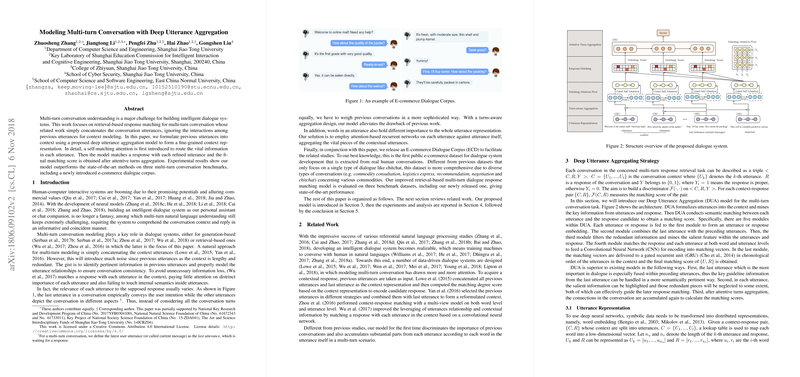Deep Utterance Aggregation for Multi-turn Conversation Modeling
The paper "Modeling Multi-turn Conversation with Deep Utterance Aggregation" presents an advanced framework for retrieval-based response matching in multi-turn dialogue systems. The research targets one of the crucial challenges in intelligent dialogue systems: understanding and modeling the context of multi-turn conversations. The authors propose a novel approach that moves beyond the prevalent strategy of simple utterance concatenation, aiming to enhance context representation through a deep utterance aggregation model. This model captures intricate interactions among utterances, ultimately achieving finer context representation that leads to improved response accuracy.
The model architecture is structured to emphasize both intra-utterance and inter-utterance semantics. It integrates several sophisticated components, including self-matching attention mechanisms and thoughtful turns-aware aggregation. These elements collectively allow for the discrimination of critical information across conversation turns and the filtering of redundant data, respectively enhancing comprehension and evidencing context pertinence.
Model Components and Innovations:
- Turns-aware Aggregation: This design aggregates utterances by focusing on their relationship to the latest utterance, which often contains key indicators of user intention. By selectively weighing prior interactions, this mechanism improves the semantic integration of the conversation context.
- Self-matching Attention: Within each utterance, words are deemed of variable importance for the overall representation. This component dynamically highlights significant elements within utterances by routing attention across the utterance sequence. Such attention mechanisms are informed by the interaction between words and the entire context, extracting essential features and enhancing overall representation.
- Response Matching Layer: The model constructs matching matrices at both the word and utterance levels to compare each context utterance with response candidates. By leveraging convolutional neural networks (CNNs), the model derives distinctive matching features, allowing better selection of relevant responses.
- Attentive Turns Aggregation: This layer aggregates matching information over previous turns through a gated recurrent unit (GRU). It is crucial in summarizing interaction dynamics and further refines response prediction accuracy.
The proposed model demonstrated superior performance on three benchmark datasets: Ubuntu Dialogue Corpus, Douban Conversation Corpus, and a newly introduced E-commerce Dialogue Corpus (ECD). Notably, these experiments revealed that the model outperformed existing approaches, such as Sequential Matching Network (SMN), by a significant margin, particularly on the more diverse ECD dataset. This indicates robust adaptability to various conversation types, extending beyond typical chit-chat scenarios to domain-specific inquiries like e-commerce consultations.
Implications and Future Directions:
The findings hold practical significance in enhancing dialogue systems, which play integral roles in customer service applications and digital personal assistants. By effectively parsing multi-turn dialogues, systems can deliver more contextually appropriate responses, thereby improving user interactions.
The introduction of a public e-commerce dataset is a notable contribution, potentially serving as a valuable resource for subsequent research exploring domain-specific dialogue systems. Future work could explore integrating explicit topic tracking or handling simultaneous multiple intentions within conversations, which remain challenges despite the model's sophisticated architecture. Further, the issue of inherently multiple correct responses in real conversations can be addressed with nuanced evaluation metrics or human-in-the-loop annotations to recognize semantically varied but correct responses.
In conclusion, the deep utterance aggregation model marks substantive progress in multi-turn dialogue modeling. By capturing nuanced contextual information more effectively, this work contributes substantially to the ongoing evolution of robust, retrieval-based dialogue systems.
